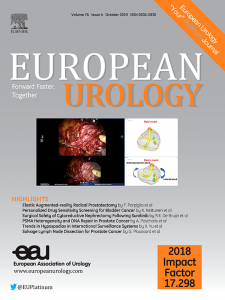European Association of Urology Guidelines on Male Sexual and Reproductive Health: 2025 Update on Male Hypogonadism, Erectile Dysfunction, Premature Ejaculation, and Peyronie’s Disease
IF 25.2
1区 医学
Q1 UROLOGY & NEPHROLOGY
引用次数: 0
Abstract
Objective
The objective of this study is to present a summary of the updated 2025 European Association of Urology (EAU) guidelines on sexual and reproductive health (SRH), focusing on hypogonadism, erectile dysfunction (ED), premature ejaculation (PE), and Peyronie’s disease (PD), providing practical recommendations on the clinical workup, with a focus on diagnosis, treatment, and follow-up.
Evidence acquisition
The panel conducted an updated systematic review of new research published in 2021–2024 in Medline, EMBASE, and Cochrane Libraries. The guidelines’ recommendations focused on key clinical decisions that would impact patient care most. Each recommendation’s strength was evaluated based on three factors: the trade-offs between benefits and drawbacks of different treatment approaches, the quality and reliability of the available evidence, and the diverse preferences and values of patients.
Key findings
Along with a detailed basic and advanced diagnostic approach for every condition, key recommendations emphasise the importance of appropriate indications and subsequent follow-up for testosterone therapy in patients with late-onset hypogonadism (LOH), a clinical condition in the ageing male combining low levels of circulating testosterone and specific symptoms associated with impaired hormone production and/or action. The decision-making algorithm for treating ED—defined as the persistent inability to attain and maintain an erection sufficient to permit satisfactory sexual performance—aims to support personalised treatment tailored to individual patients, according to the invasiveness, tolerability, and effectiveness of the different therapeutic options and patients’ expectations. Hence, patients should be fully counselled with respect to all available treatment modalities. The EAU guidelines adopted the definition of PE, which has been developed by the International Society for Sexual Medicine. After the subtype of PE has been defined, patient’s expectations should be discussed thoroughly, and pharmacotherapy must be considered as the first-line treatment for patients with lifelong PE, whereas treating the underlying cause must be the initial goal for patients with acquired PE. An accurate baseline assessment of patients with PD should differentiate between acute and stable phases of the disorder. Surgical treatment for PD should be offered to patients having a penile deformity with a negative impact on sexual function: patients with concomitant ED should be offered penile prosthesis implantation.
Conclusions and clinical implications
This overview of the 2025 EAU SRH guidelines offers valuable insights into the diagnosis, treatment, and follow-up of LOH, ED, PE, and PD.
欧洲泌尿外科协会男性性健康和生殖健康指南:2025年男性性腺功能减退、勃起功能障碍、早泄和佩罗尼病的最新进展
本研究的目的是总结更新的2025年欧洲泌尿外科协会(EAU)关于性与生殖健康(SRH)的指南,重点关注性腺功能减退、勃起功能障碍(ED)、早泄(PE)和Peyronie病(PD),为临床检查提供实用建议,重点是诊断、治疗和随访。证据获取专家组对Medline、EMBASE和Cochrane图书馆在2021-2024年发表的新研究进行了更新的系统综述。该指南的建议侧重于对患者护理影响最大的关键临床决策。每个推荐的强度是基于三个因素来评估的:不同治疗方法的优缺点之间的权衡,现有证据的质量和可靠性,以及患者的不同偏好和价值观。除了针对每种疾病详细的基础和先进的诊断方法外,主要建议还强调了对迟发性性腺功能减退(LOH)患者适当适应症和后续随访睾酮治疗的重要性。LOH是一种老年男性临床症状,伴有循环睾酮水平低和与激素产生和/或作用受损相关的特定症状。治疗ed的决策算法被定义为持续无法达到和维持足以允许令人满意的性行为的勃起,目的是根据不同治疗方案的侵入性、耐受性和有效性以及患者的期望,支持针对个体患者量身定制的个性化治疗。因此,应充分告知患者所有可用的治疗方式。欧亚联盟的指导方针采用了由国际性医学学会制定的性行为的定义。在明确PE亚型后,应充分讨论患者的期望,对于终身PE患者,必须将药物治疗作为一线治疗,而对于获得性PE患者,治疗根本原因必须是首要目标。对帕金森病患者的准确基线评估应该区分疾病的急性期和稳定期。对于阴茎畸形对性功能有负面影响的PD患者,应给予手术治疗;同时伴有ED的患者,应给予阴茎假体植入。结论和临床意义2025年EAU SRH指南概述为LOH、ED、PE和PD的诊断、治疗和随访提供了有价值的见解。
本文章由计算机程序翻译,如有差异,请以英文原文为准。
求助全文
约1分钟内获得全文
求助全文
来源期刊

European urology
医学-泌尿学与肾脏学
CiteScore
43.00
自引率
2.60%
发文量
1753
审稿时长
23 days
期刊介绍:
European Urology is a peer-reviewed journal that publishes original articles and reviews on a broad spectrum of urological issues. Covering topics such as oncology, impotence, infertility, pediatrics, lithiasis and endourology, the journal also highlights recent advances in techniques, instrumentation, surgery, and pediatric urology. This comprehensive approach provides readers with an in-depth guide to international developments in urology.
 求助内容:
求助内容: 应助结果提醒方式:
应助结果提醒方式:


